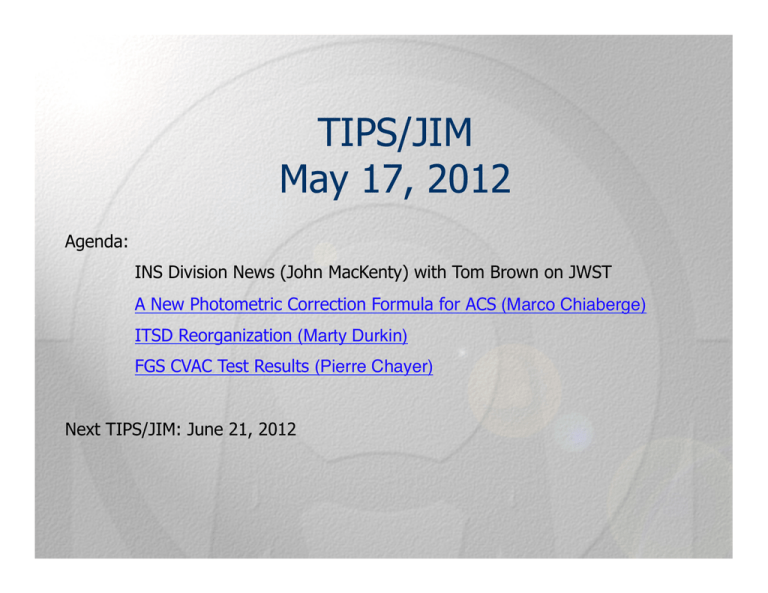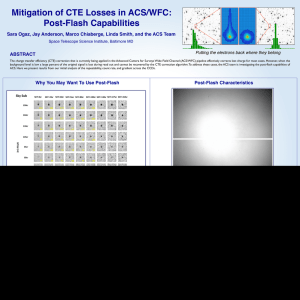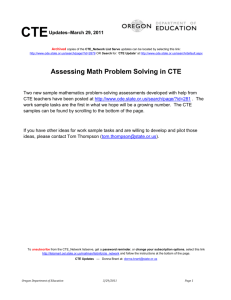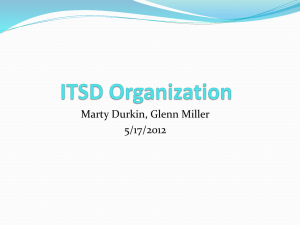TIPS/JIM May 17, 2012
advertisement

TIPS/JIM May 17, 2012 Agenda: INS Division News (John MacKenty) with Tom Brown on JWST A New Photometric Correction Formula for ACS (Marco Chiaberge)! ITSD Reorganization (Marty Durkin)! FGS CVAC Test Results (Pierre Chayer)! Next TIPS/JIM: June 21, 2012 JWST NEWS • Geoff Yoder is replacing Rick Howard as JWST Program Director at NASA HQ • MIRI should be delivered to GSFC on May 29 • MIRI detector analysis proceeding in parallel at JPL • FGS+NIRISS should be delivered to GSFC by the end of July • NIRCam will be in I&T this summer, with a significant staffing contribution from STScI • The Project is currently working to recover mass margins by exploring various options TIPS/JIM May 17, 2012 Agenda: INS Division News (John MacKenty) with Tom Brown on JWST A New Photometric Correction Formula for ACS (Marco Chiaberge)! ITSD Reorganization (Marty Durkin)! FGS CVAC Test Results (Pierre Chayer)! Next TIPS/JIM: June 21, 2012 A NEW CTE PHOTOMETRIC CORRECTION FORMULA FOR ACS Marco Chiaberge TIPS meeting 05/16/2012 CHARGE TRANFER EFFICIENCY (CTE) per pixel Defined as CTE = 1 - ΔQ/Q = 1 - CTI For an ideal CCD CTE = 1.0 For real CCDs CTE < 1 Manufacturing imperfections in the crystalline lattice Radiation damage (increasing with time) CTE on ACS was not 1.0 at lunch! The total CTE is CTEN significant effect for large CCDs CTE depends on flux, sky level, # of transfers The effect of CTE on stellar photometry is to reduce the measured flux A significant fraction (all?) of the “lost” flux goes into the “tail” Timeline of ACS CTE corrections Time dependent formula based on 3 epochs March 2003 – Feb 2004 Riess & Mack ISR 2004-006 Revised formula Chiaberge et al. ISR 2009-01 New approach for data analysis, 4 epochs Increased accuracy Δmag = 10A • SKYB • FLUXC • Y/2000 • (MJD-52333)/365 Linear in log Δmag v log flux and log sky! Anderson & Bedin 2010 pixel-based CTE correction Included in the new CALACS WHY DO WE STILL NEED A PHOTOMETRIC CORRECTION FORMULA? We need to keep monitoring the time dependence and make sure that photometry is correctly recovered Some users may prefer to use a correction formula. The correction formula may be more accurate for some regions of the parameter space What should we use for extended sources? Photometric test D C Y1 B A Y2 Y Transfers=ΔY=Y1-Y2 WFC For y=1024 ΔY=0 Δmag=0 Post-SM4 Observations Programs: CAL/ACS 11880, 12385, 12730 FILTERS: F606W, F502N EXP TIMES: Between 30s and 400s 5 Background levels between ~0.1 and 40eLow sky CR-REJECTION, no dithering 1 epoch/cycle Target: 47 Tuc (7’ off center) Cycle 19: + pointing 3’ south of 47Tuc center for the lowest sky level 9 external orbits 47 Tuc 7’ off center ~ 2000 stars 47 Tuc 3’ off center ~ 7000 stars ANALYSIS PROCEDURE (semi-automatic, thanks to Pey Lian!) • 1 Generate “clean”, deep, drz image using all data • 2 Identify saturated pixels and mark them on the DQ extension of FLT files • 3 Mask out area around the saturated stars • 4 Find stars on the deep mosaic, then measure flux of all stars that are detected on (both of) the single_sci files (aperture phot) • 5 Fit Δmag vs # of transfers for different bins of flux (rejecting outliers with iterative sigma clipping) • 6 Find the best fit model parameters to reproduce the dependence of Δmagy=2000 on Sky and Flux levels F502N 30s November 2011 A linear fit is performed for each bin of flux (red lines) Rms errors on the slope are estimated (yellow lines) At y = 2000 Mag loss of 0.56 ± 0.07 mag CTE Correction formula assumed dependence on flux Δmag = 10A • SKYB • FLUXC • Y/2000 • (MJD-52333)/365 2 problems: Cycle 17 Cycle 19 Y=2000 CTE improves at low Signal levels??? 0.6 e0.3e- 32e- Large deviations from the assumed linear dependence Photometry with different detection thresholds: 3 and 10σ BUT THIS IS WHAT USERS NORMALLY DO! Average flux I measure in that bin Δmag N 50e- Far from amplifiers 100e- Flux Close to amplifiers Detection threshold CTE Correction formula assumed dependence on flux Δmag = 10A • SKYB • FLUXC • Y/2000 • (MJD-52333)/365 Cycle17 19 Cycle 0.6 e0.3e- 32e- Much better represented by a linear relation in Δmag v Log sky Cycle 19 Δmag = α Log flux + β α,β = α(sky), β(sky) 0.6 e14e- Δmag = [α Log(flux) + β] • y/2000 α = p Log(sky) + q β = p’ Log(sky) + q’ Δmag = p Log(sky) Log(flux) + q Log(flux) + p’ Log(sky) + q’ p, q, p’, q’ = p(t), q(t), p’(t), q’(t) Δmag = p Log(sky) Log(flux) + q Log(flux) + p’ Log(sky) + q’ p, q, p’, q’ = p(t), q(t), p’(t), q’(t) Linear fit using “R”, for each epoch The new time dependence does not assume CTE = 1 at T = Tlaunch T – Tlaunch (d) Comparison with pixel-based CTE correction CTE formula is more accurate than the pix-CTE correction at the lowest background levels RESULTS • A new accurate CTE photometric correction formula is now available • The accuracy is comparable to (or better than!) the pix-cte correction • Does not depend on the assumption of CTE = 1 at T = Tlaunch FUTURE WORK (from TIPS 2009) • New observations after SM4 using CR-REJ and possibly dithering • Procedures should be made automatic (or semi-automatic) • Formula for different aperture radii • Better data might lead to a better characterization Different form of the formula? FUTURE WORK • Better estimate of the errors on the coefficients • Formula for different aperture radii • Extended sources? • Webpage for correction Thanks to Jay, Linda, Roberto and Pey Lian Photometric test Allows to measure the total flux lost and provides correction formulae for photometry. Stars are positioned at different distance from the readout amplifier thus changing the number of transfers and therefore the impact of CTE. D B WFC C A 47 Tuc F606W 40s exp Long vs short: find stars in F606W 400s Measure the flux of all stars in F502N 30s in F606W 400s i No correction Corrected TIPS/JIM May 17, 2012 Agenda: INS Division News (John MacKenty) with Tom Brown on JWST A New Photometric Correction Formula for ACS (Marco Chiaberge)! ITSD Reorganization (Marty Durkin)! FGS CVAC Test Results (Pierre Chayer)! Next TIPS/JIM: June 21, 2012 Marty Durkin, Glenn Miller 5/17/2012 Goal of ITSD Provide outstanding customer service and IT tools to the user community to enable the Institute to meet its Mission, Science and Business goals. Feedback on ITSD We obtained input from: Our Customers: Meeting with Division Management, Director ‘s Office and Institute staff on their perception of ITSD ITSD Staff: Focus Group report from Dr. Fred Mael ITSD Management: Branch Managers analyzed work flow and issues within the Division What did we find from this feedback? ITSD does a tremendous amount of good work but there are areas where we need to improve. Focus Areas Areas we are focusing on to make ITSD more effective: Increase the role of the customer in how decisions are made and priorities are set Clear understanding of the roles and primary points of contact Streamline and simplify processes ITSD Approach Going Forward Build and maintain stronger relationships with our customers Receptive to new ideas and technologies Recognize the value of failing forward Build capable and adaptable teams Structural Improvements Streamline and clarify workflow through organizational changes Align the focus of the teams with customer needs Create Technical Lead & Chief Technical Lead roles Technical Leads are identified points of contact and will lead and coordinate work across the work units. Part of their role is to partner with the OED Chief Engineers in the relevant domains. ITSD Current Org Structure ITSD New Org Structure ITSD New OrganizaBon 4 Branches Staff Desktop and OS Support Branch Helpdesk (Val Ausherman) Desktop OS support (Jim Grice) Mission & Server Support Branch Mission support HST(Patrick Taylor) JWST (Matt Sienkiewicz) CMO (Ron Russell) SCIENCE (Tony Darnell) Servers (Phil Grant) ITSD New OrganizaBon (cont’d) 4 Branches (cont’d) Infrastructure Support Branch Network/VOIP (Gary Gladney) Security (Jamie Lipinski) Storage & Backups (Prem Mishra) Email & Calendaring (Greg Sachs) Database (Jeff Wagner) ITSD New OrganizaBon (cont’d) 4 Branches (cont’d) Business, Applications and User Tools Branch Business Tools (Joy Hale) Custom Applications (Joy Hale) A/V (Calvin Tullos) Documentation and Handbooks Web (Leigh McCuen) Branches will come up with final branch names. IT Services Division ReorganizaBon Next Steps Deploy new structure (4/9/2012) Finalize branch names (5/11/2012) Customer Service training (5/2012) Update and communicate IT roadmaps (6/2012) Define and advertise priorities of ITSD work and how this ties into the Institute’s mission. (6/2012) Reinforce values and behaviors (ongoing) What We Plan to Accomplish Our customers will view us as the IT source for enabling them to get their jobs done. Modern and innovative approaches and solutions are an integral part of the way we work. Assessment Metrics Response time to helpdesk requests Time to deliver new systems Meeting deliverables Number of new technology evaluations Customer Feedback TIPS/JIM May 17, 2012 Agenda: INS Division News (John MacKenty) with Tom Brown on JWST A New Photometric Correction Formula for ACS (Marco Chiaberge)! ITSD Reorganization (Marty Durkin)! FGS CVAC Test Results (Pierre Chayer)! Next TIPS/JIM: June 21, 2012 JWST FGS & NIRISS CVAC Tests November 1, 2011 − January 25, 2012 Pierre Chayer, André Martel, Alex Fullerton, Ed Nelan, Kevin Volk, Anand Sivaramakrishnan, Sherie Holfeltz, Van Dixon, Paul Goudfrooij, Deepashri Thatte, Harry Ferguson Comdev Canada, CSA, UdeM, HIA FGS: Fine Guidance Sensor NIRISS: Near-InfraRed Imager & Slitless Spectrograph 2012 May 17 1 Fine Guidance Sensor (FGS) Optical Layout Role of FGS: Provides centroids to the Attitude Control System. Pick-Off Mirror Focus Mirror Detectors 100 mm TMA Mirrors 2m 2012 May 17 2 FGS Optical Assembly 2012 May 17 3 FGS at the David Florida Laboratory 2012 May 17 4 FGS entering chamber 2012 May 17 5 FGS Optical Assembly 2012 May 17 6 FGS in chamber 2012 May 17 7 Optical Ground System Equipment (OGSE) 2012 May 17 8 Optical Ground System Assembly (OGSE) NIRISS NIRISS 2012 May 17 9 Floor plan for CVAC test 2012 May 17 10 Temperature Profile Slower Cool-down • ~80K Plateau moved up • • 3x 37 K Plateaus 100 ~80 K 40.5 K Plateau Extended 40.5 K Plateau Normal warm-up 37 K # 1 37 K # 3 37 K # 2 22 K Survival 10 0 2 4 6 8 10 11 13 15 17 19 21 23 25 27 29 30 31 33 35 37 39 41 43 45 47 49 51 53 55 57 59 61 63 65 67 69 71 73 75 77 79 81 83 85 • CVAC Temperature Summary Temperarure (K) • Test Day FGS A verage 2012 May 17 Thermal Strap KM A verage IP A verage TV3 Chamber A verage (K) GHe A verage 11 Chamber background 2012 May 17 12 Location of OGSE Spots in G1 2012 May 17 13 Images of OGSE Sources 2012 May 17 14 Bad Pixel Maps 2012 May 17 15 IDENTIFICATION • • • • • • • • • Identification of the Guide Star. Full-frame: strip readout: 36 (64x2048) strips, 8 overlaps. ID strip integration time: 0.32 sec. Strip readout: read-read-reset-read-readè CDS1 and CDS2. Create two lists of bright objects. Merge the two lists è one list. Identify guide star and ref. stars è Triad algorithm. Success è Guide star is identified. ID timing: 82.12 sec, G1, 5 stars, 8 candidates. 2012 May 17 16






